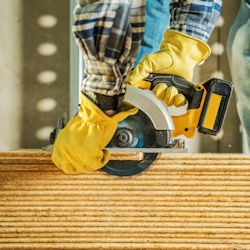Hand Protection When Working With Tools
Careful attention must be given to protecting your hands when working with tools and machinery.
Power tools and machinery must be fitted with guards or designed in such a way that prevents the hands from coming into contact with the point of operation, power train, or other moving parts.
To protect hands from injury when operating or working near machinery with moving parts, it is important to:
- Ensure that guards are always in place and used: When operating machinery or power tools, make sure the protective guards are securely attached and functioning correctly. They act as a physical barrier to prevent accidental contact with dangerous moving parts.
- Always lock-out machines or tools and disconnect the power before making repairs: Before performing any maintenance or repair work on machinery or power tools, it is crucial to turn off the power source and use lock-out procedures to ensure the equipment cannot be accidentally energized. This prevents unexpected starts that could lead to injuries.
- Treat a machine without a guard as inoperative: Consider a machine with a missing, damaged, or malfunctioning guard as non-operational. Operating machinery without the necessary guards poses serious risks and should be avoided until the guards are properly repaired or replaced.
- Do not wear gloves around moving machinery or parts: OSHA strictly advises that protective gloves should not be worn near moving machinery. Where
risk of injury is increased because of machinery, wearing of gloves is prohibited. Gloves must not be worn when and where they can get caught in powered machinery.
Examples include, but are not limited to, the following:
- Feeder, induction, stacker, and transport conveyor paths of the mail processing machines
- Conveyors with pinch and/or nip points; and
- Drills, chain drives, and rotating shafts with catch points.
Knowledge Check Choose the best answer for the question.
5-7. Do not wear gloves when exposed to _____.
You forgot to answer the question!

